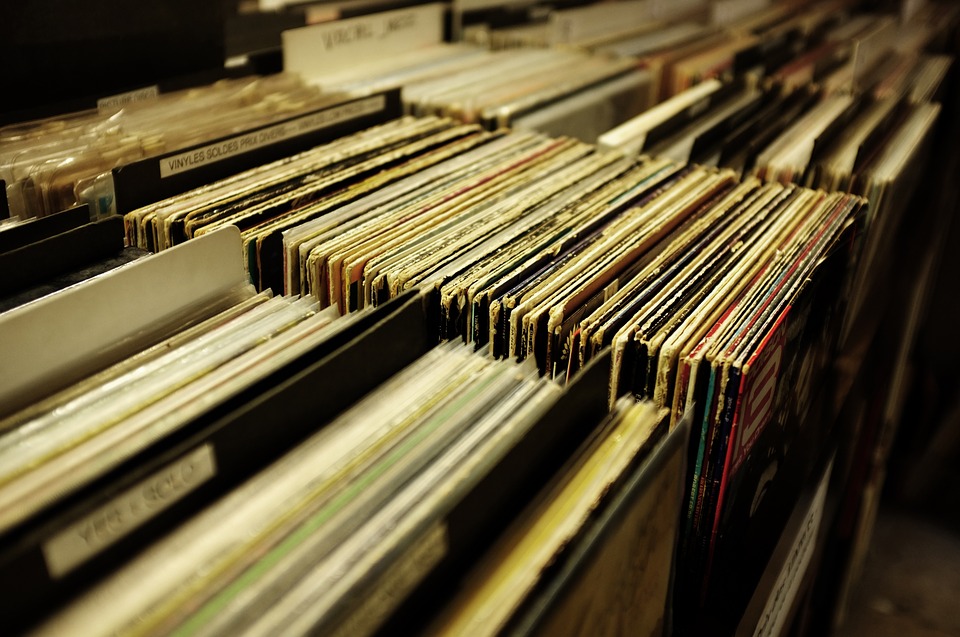Prior to the vinyl, music was only ever played live
Musicians always played music live in a public concert or within a domestic setting. The first recordings and the history of vinyl, therefore, brought dramatic changes. Thomas Edison’s “original sound recording patent [dating back to] 1877” [note]Osborne, 6 2012, pg. 3[/note] and the first Emile Berliner record from 1889, are the cornerstones of sound recording. Radio Broadcasting started a couple of years later. The British Broadcasting Corporation, for example, launched their broadcasting in 1922 [note]BBC, 2001[/note].
The vinyl is born
Columbia Records held a press conference at the Waldorf-Astoria Hotel in New York City/USA on the 21st of June 1948. They presented a new container for music, the vinyl long-player to add to the history of vinyl. Columbia Records also had invented a player for it. By negotiating a deal with Philco Radio Company in Philadelphia, Columbia Records had battled its problems with not having their own record player manufacturer [note]Morton, 2004, pg. 137[/note]. The vinyl LP is a microgroove disc and plays with 33 1/3 rpm (rounds per minute). The duration of the music is twenty-three minutes per side with a diameter of 12 inches [note]History of the LP Record, 2014[/note].
The shellac disc became outdated
Previously, the shellac record was made of secretion of female ants from “the Malay Peninsula and French Indochina” [note]Osborne, 2012, pg. 67[/note]. During World War II “the Japanese occupied both territories […], consequently for the West shellac was in short supply” [note]Osborne, 2012, pg. 67[/note]. The new length of vinyl means that more musical content can be pressed onto it. What is more, the harder consistency of the vinyl is much more practical in playing and transporting. The vinyl LP consists of a mixture of “vinyl chloride and vinyl acetate, known as Vinylite” [note]The History of the Record LP, 2014[/note].
The vinyl could hold more information than previous formats
The higher number of grooves per inch made the vinyl stand out. With 224 to 226 grooves per inch, the vinyl is playing off the shellac record with its 80 to 100 grooves per inch [note]see The History of the Record LP, 2014[/note]. The harder material plus the higher number of grooves per inch combined with the new speed made the vinyl so successful. In order to establish the new vinyl record, Columbia was willing to share its invention. But RCA Victor, the other big record label at that time, took down the offer. RCA Victor was upset that Columbia developed the vinyl record without their knowledge [note]Millard, 2005, pg. 206ff[/note].
RCA Victor adds the 45` 7inch Vinyl
Instead, they pushed their own research further till they had manufactured the 45 ́. The number “45” refers to the special speed this record is played, 45 rounds per minutes. The RCA Victors 45 ́ was just 7 inch in diameter. That was due to the fact that the 45 ́ mostly were used in upcoming jukeboxes [note]see Osborne, 2012, pg. 118[/note]. This literally ended in the “battle of speeds” between Columbia Records and RCA Victor. It confused a lot of consumers and gave the new development a rather bumbling start [note]see Coleman, 2003, pg. 60[/note]. The vinyl record allowed people to consume music in an unprecedented way. However, it was also the breeding ground for a completely new concept in music history.
The vinyl album helped shape ‘the album’ as an art form.
The “Album” is born, i.e. a set arrangement of individual songs which combine and interact together in order to create a new whole [note]see Osborne, 2012, pg. 87[/note]. Bands like The Beatles or The Rolling Stones were taking it to unknown highs, composing their music just for this format. Even thinking about the artistic dynamics of where to change the side of the vinyl. Albums like “Abbey Road” (The Beatles) or “Let it Bleed” (The Rolling Stones) are therefore unique pieces of music history.
Cover Art shapes vinyl history
What is more, the vinyl LP sleeve offers a very large cover, due to its diameter of 12 inch. Alex Steinweiss had an ingenious idea for the, until then blank, cover of an LP. In 1939 he started illustrating covers for Columbia Record which soon became legendary. Those influenced the term “cover art”. His illustrations were seen as a piece of iconic art [note]see Elborough, 2009, pg. 32; Appendix no. 1[/note]. Other record companies retightened quickly after that.
For more vinyl information please read the whole scientific research.

